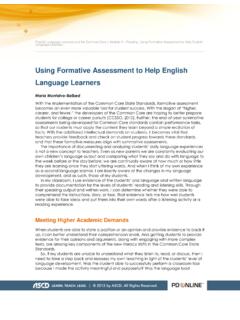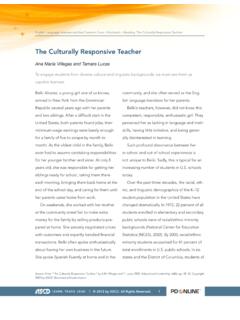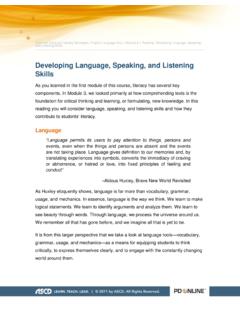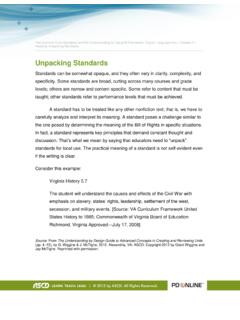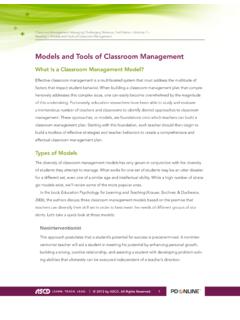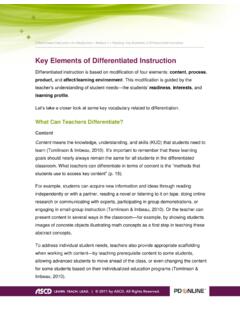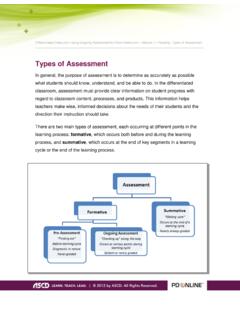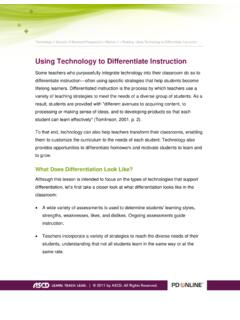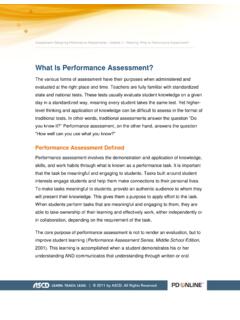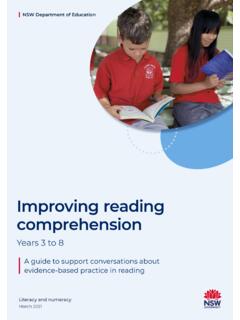Transcription of Differentiation for Readiness
1 Differentiated Instruction: Teaching with Student Differences in Mind > Module 4 > Reading: Differentiation for Readiness _____ Differentiation for Readiness Student Readiness for learning on a particular day with a particular topic is influenced by many factors. Some of these are: Prior knowledge or general experience, including the degree of previous school success in this topic or discipline Knowledge, understanding, and skill in topic prerequisites Existing misunderstandings held about the topic or discipline General communication, thinking, reasoning, and other skills Developmental stage (physical, cognitive, or affective) Current and past physical and mental health Interest in and attitude toward school, subject, topic, or teacher Learning profile match or mismatch of the task with student preferences Student Readiness is not a fixed factor.
2 Sometimes a student who typically struggles in a subject may have a surprisingly great amount of background knowledge in a specific topic. In this case, the student may be ready for more advanced work than usually expected. On the other hand, students who are usually quite advanced may be missing some Differentiated Instruction: Teaching with Student Differences in Mind > Module 4 > Reading: Differentiation for Readiness Page | 2 _____ prerequisites in a topic or may be distracted by other issues in their lives.
3 In this case, they may need a more scaffolded experience to be successful. When differentiating for Readiness , teachers try hard to look at a student s Readiness for specific content, processes, or products, rather than making decisions based solely on measures of general ability or aptitude, or on school-assigned labels, such as special education or gifted. According to Carol Ann Tomlinson, It is fairer and more accurate to look at Readiness for a particular endeavor instead of using one skill to make a judgment about general ability (Tomlinson, 1999, p. 53). What Does Differentiation for Readiness Look and Sound Like?
4 Teachers deal with Readiness differences via several paths: tiered tasks and small-group instruction are two of the most common. Tiered tasks are those tasks that are designed at different levels of depth or complexity to match students next steps for learning needs. Tiered tasks may be assigned by the teacher, which is most common, or chosen by the students after they have had some instruction in how to choose well and why they might wish to do so. Small-group instruction occurs when, based on formal or informal assessment data, it is clear that a student or group of students has a particular need for direct instruction or small-group support at a specific level that would not be appropriate for the whole class.
5 Using the Tiering Strategy The following classroom examples are of teachers using the tiering strategy in their classroom. Column A is what you might hear the teacher say, and column B explains why this is an example of Differentiation for Readiness . Column C provides a possible common KUD. Differentiated Instruction: Teaching with Student Differences in Mind > Module 4 > Reading: Differentiation for Readiness Page | 3 _____ A: What you hear the teacher say B: What makes this an example of Differentiation for Readiness C: The KUD of this activity For this activity, you will use your just-right book to help you answer questions about story elements.
6 This is a very common example of differentiating student access to content via Readiness . In this case, it is the teacher who has decided the appropriate level of book that the students will use. All students are working with the following KUD related to story elements, but at an appropriate reading level: Know story elements. Understand that you can find the same story elements in all stories. Each element has a different role in communicating the author s message. Be able to identify story elements and describe how they work together to deliver the author s message. You will all be solving problems involving graphing equations.
7 Most of you will find that problems 1-5, 6-8, and 10 will help you practice what we have learned and help you grow. If you feel that you are ready for a challenge, do problems 4-12, instead. This can be classified as an example of differentiating process or content via Readiness . The teacher asks the students to choose the regular or advanced set of problems, according to what they feel ready to tackle. If the teacher is concerned that students will not make a good choice of level, she should either talk to students about the importance of working just a bit beyond their current level of expertise or assign the different sets of problems to students based on her current knowledge of their Readiness for the task.
8 The KUD might look something like Know signs and symbols used in equations, as well as parts of a graph and their functions. Understand that graphing equations can help you visualize what is happening in a problem or situation. Be able to graph equations. We will all be reading about the various concepts of intelligence in psychology. Most of you will read the chapter in our text book. I am going to ask This is an example of content Differentiation for Readiness . This teacher has a few students who read beyond post-secondary level and so he has decided to ask them to read a more advanced text on the same topic to help them gain A possible KUD might be Know current thoughts about intelligence.
9 Understand that experts disagree about what intelligence is, where it comes from, and Differentiated Instruction: Teaching with Student Differences in Mind > Module 4 > Reading: Differentiation for Readiness Page | 4 _____ some of you to read about the same topic in a current journal article on the subject. knowledge of the topic and continue to stretch their reading comprehension skills. how (and if) it is developed over time.
10 Be able to explain the varied theories about intelligence in the field of psychology. Please visit the stations that you think will most help you prepare for the unit test on natural resources. Take the check your Readiness quiz if you are not sure what you This is an example of differentiating content or process for student Readiness (depending on what the students do at the stations). Each station deals with a different concept from the chapter. Notice that the teacher provides some guidance for students who are not sure of where they should go, via a quick self-correcting quiz. A possible KUD might be Know natural resources in a given region and their current state of sustainability.
